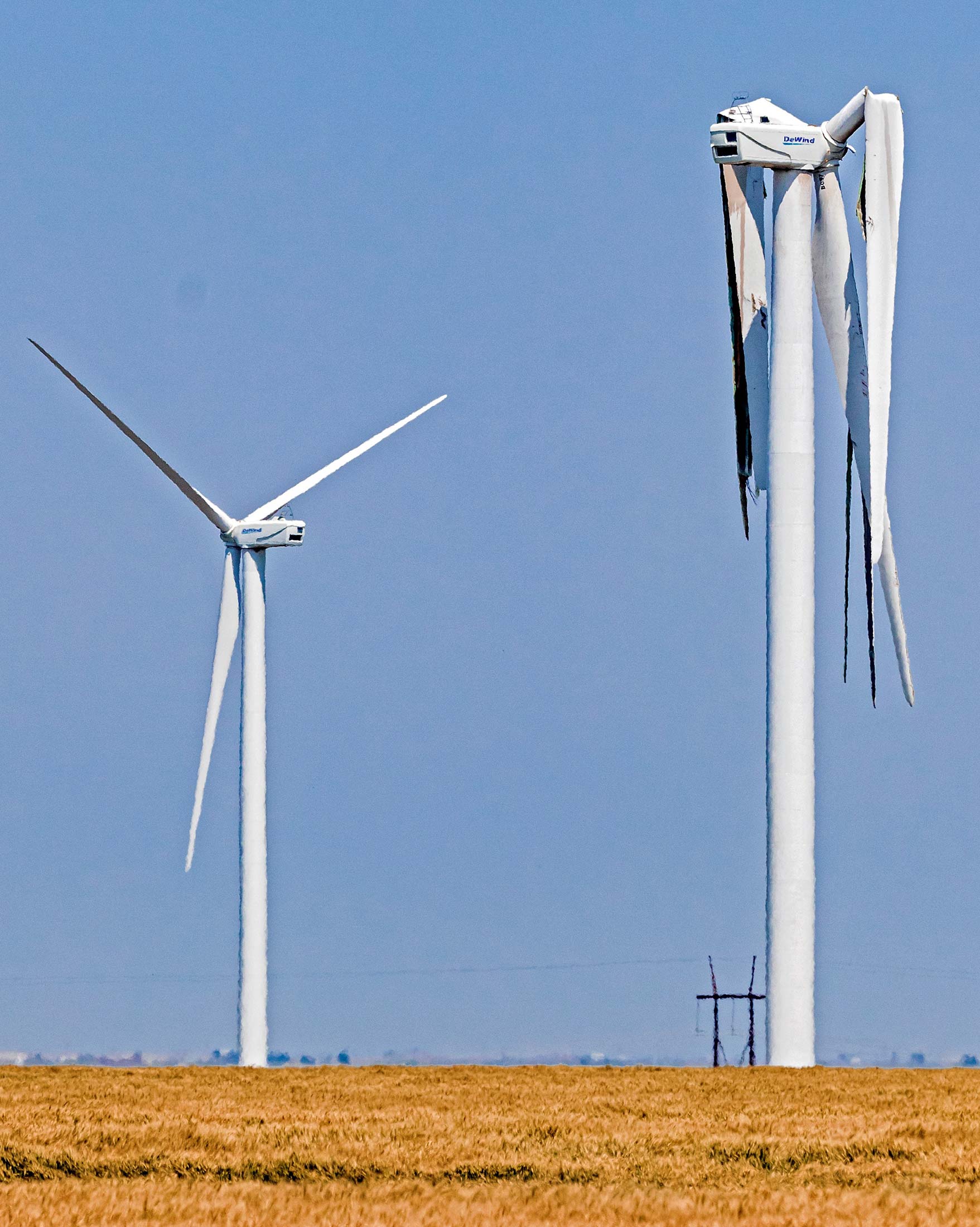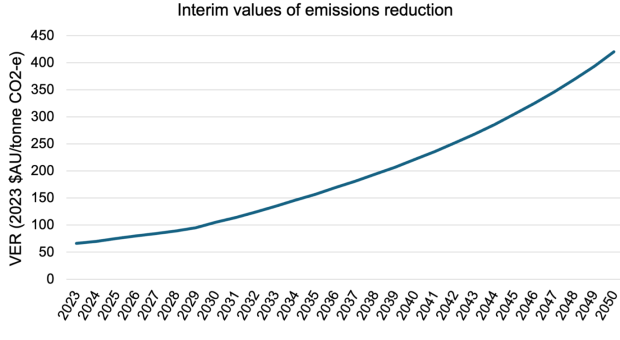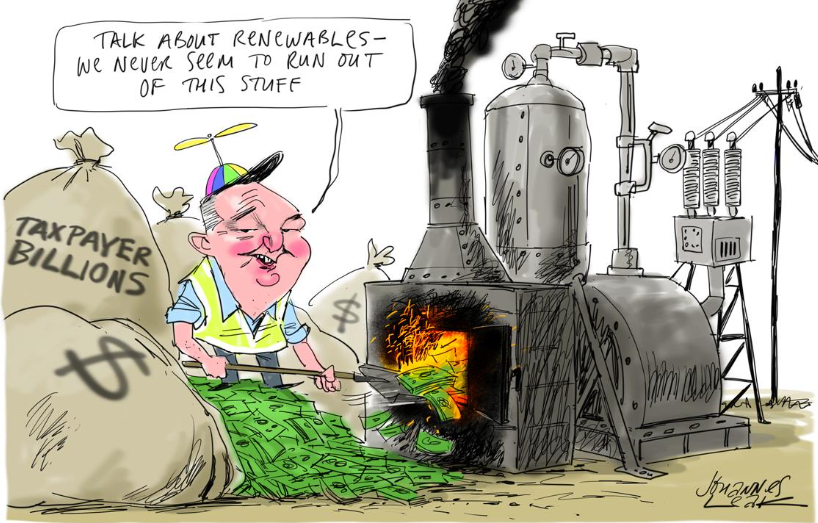The staggering cost of carpeting the countryside with forests of wind turbines and seas of solar panels are ultimately borne by you: the unwitting taxpayer and power consumer.
There is no commercial value in wind and solar power because there is no demand for electricity that can’t be delivered as and when consumers need it. Hence the hundreds of billions of dollars in subsidies that are poured into the pockets of wind and solar outfits around the globe, every year. Strip away the subsidies and the wind and solar ‘industries’ would disappear in a heartbeat.
In Australia, the rent-seeking class have never had it so good: the left-wing of the Labor Party (in cahoots with the crazies that call themselves Greens) have delivered a Federal budget designed to enrich crony capitalists and impoverish everyone else.
Central to their grand 5-year-plan are even further gifts taxpayer’s cash to wind and solar outfits and a raft of other ‘infant industries’ [read enterprises which will never attract a nickel in private investors’ money without a government-guaranteed return – like so-called ‘green’ hydrogen].
None of what’s been put forward has a hope of improving this country’s economic prosperity. All of what’s on offer signals the annihilation of those remaining industries where energy costs count, as Alan Moran explains below.
Budget review: net zero cannibalises our prosperity
Spectator Australia
Alan Moran
16 May 2024
The public is receiving the Budget with a sense of bored irrelevance. People are pleased to see a $300 cut in their electricity bills, hoping that someone else is financing this, but eyes glaze over at the billions of dollars of taxpayer money with which the government promises to catapult the economy into the nirvana that is the green energy transition. And nobody seems concerned that spending is at its highest since the Hawke-Keating years of the early 1990s.
But the reality is this budget not only amplifies the already excessive government spending levels, but adds measures that aim to transform the economy by injecting unprecedented government control over business. Taxpayers will plough $22.7 billion into Labor’s Future Made in Australia agenda.
At best, this is wasteful but in reality, it is harmful since the funds are intended to combine with other regulatory measures in order to destroy the coal and gas energy generation facilities. These facilities were built up over decades to form the backbone of the nation’s once highly efficient low-cost power, important for homes and crucial for the production activities that determine our living standards. Energy-intensive smelting is already under special care and we are now seeing food manufacturers talking of moving their facilities offshore where energy and other costs are more welcoming.
The damage the policies cause is compounded by them, in the Treasurer’s words, helping to ‘unlock greater private investment’ in five priority areas. These he describes as green hydrogen, critical minerals, green metals, low carbon liquid fuels, and clean energy manufacturing. Belying any understanding of economic policy, the Treasurer claims that his policy settings avoid picking winners via direct subsidies and are instead ‘leaning on the tax system’ to support the target sectors; he adds ‘if the projects can’t stand up on their own and get into production, they don’t get taxpayer money’.
To the degree that the direct and indirect measures succeed, they bring about a double whammy. First, they cannibalise the available funds from activities that would otherwise maintain and raise living standards. And secondly, they divert them into expenditures that have the opposite effect.
Australian governments (and governments of some other developed nations) are forcing the economy along a non-commercial green path. We have seen such plans come to grief in some developing countries. Sri Lanka offered a trial run in 2021 when the green-left persuaded the government to ban fossil fuel-based fertilisers; that ended badly with plummeting crop production, 80 per cent food price increases and the President being forced to flee the country.
In the past, government policies that overrode commercial decisions did so by seeking to replicate well-documented overseas successes. Some, like the Soviet Union, seized income from producers and redirected it with limited and painful success into catch-up industry activities. Australia adopted import-substitution, infant industry policies; when these were reversed by the Hawke-Keating deregulatory reforms we experienced a surge in productivity and income levels
The present path differs from those of previous intervention eras, which though ending in failure were seeking to develop industry growth patterns along well-trodden paths. The Future Made in Australia programs are based on the government selecting particular technologies and using taxpayer funds to finance their development. They are therefore inherently riskier.
The public is receiving the Budget with a sense of bored irrelevance. People are pleased to see a $300 cut in their electricity bills, hoping that someone else is financing this, but eyes glaze over at the billions of dollars of taxpayer money with which the government promises to catapult the economy into the nirvana that is the green energy transition. And nobody seems concerned that spending is at its highest since the Hawke-Keating years of the early 1990s.
But the reality is this budget not only amplifies the already excessive government spending levels, but adds measures that aim to transform the economy by injecting unprecedented government control over business. Taxpayers will plough $22.7 billion into Labor’s Future Made in Australia agenda.
At best, this is wasteful but in reality, it is harmful since the funds are intended to combine with other regulatory measures in order to destroy the coal and gas energy generation facilities. These facilities were built up over decades to form the backbone of the nation’s once highly efficient low-cost power, important for homes and crucial for the production activities that determine our living standards. Energy-intensive smelting is already under special care and we are now seeing food manufacturers talking of moving their facilities offshore where energy and other costs are more welcoming.
The damage the policies cause is compounded by them, in the Treasurer’s words, helping to ‘unlock greater private investment’ in five priority areas. These he describes as green hydrogen, critical minerals, green metals, low carbon liquid fuels, and clean energy manufacturing. Belying any understanding of economic policy, the Treasurer claims that his policy settings avoid picking winners via direct subsidies and are instead ‘leaning on the tax system’ to support the target sectors; he adds ‘if the projects can’t stand up on their own and get into production, they don’t get taxpayer money’.
To the degree that the direct and indirect measures succeed, they bring about a double whammy. First, they cannibalise the available funds from activities that would otherwise maintain and raise living standards. And secondly, they divert them into expenditures that have the opposite effect.
Australian governments (and governments of some other developed nations) are forcing the economy along a non-commercial green path. We have seen such plans come to grief in some developing countries. Sri Lanka offered a trial run in 2021 when the green-left persuaded the government to ban fossil fuel-based fertilisers; that ended badly with plummeting crop production, 80 per cent food price increases and the President being forced to flee the country.
In the past, government policies that overrode commercial decisions did so by seeking to replicate well-documented overseas successes. Some, like the Soviet Union, seized income from producers and redirected it with limited and painful success into catch-up industry activities. Australia adopted import-substitution, infant industry policies; when these were reversed by the Hawke-Keating deregulatory reforms we experienced a surge in productivity and income levels
The present path differs from those of previous intervention eras, which though ending in failure were seeking to develop industry growth patterns along well-trodden paths. The Future Made in Australia programs are based on the government selecting particular technologies and using taxpayer funds to finance their development. They are therefore inherently riskier.
Their starting blocks are the existing forms of green energy: wind, solar, and batteries (and Snowy 2, the costs of which have ballooned from $2 billion to $20 billion with no end in sight). Although CSIRO and other government agencies proffer advice that renewable energy supplies are the cheapest forms of energy, their continued reliance on subsidies refutes this. The government in announcing its multiple support measures does not publicise the estimated total bill (in my estimates, $15.6 billion a year even before the latest props). At one time the budget papers had a compendium of the measures. But this was discontinued in 2011, when Tony Abbott as opposition leader was drawing attention to the cost, prompting Prime Minister Julia Gillard to famously maintain, in a highly choreographed statement, ‘There will be no carbon tax in a government I lead!’ That pledge was promptly reneged upon once she was re-elected with the support of the Greens.
But some corners of the bureaucracy illuminate some of the costs. Thus, the Australian Energy Regulator (AER) has estimated the de facto carbon tax required over the years to 2050 to achieve the government’s Net Zero ambitions. The AER estimates a carbon tax rising to some $420 per tonne by 2050 will be needed. That amounts to a tenfold increase on the 2015 price of electricity (the last year before carbon-suppressing regulations forced closures of coal-fired electricity generators and the subsequent wholesale price increases).
The fact is that the ‘energy transition’ technologies do not work and probably will never work. Imposing them onto the economy will further increase costs and undermine reliability. At the very least this will reduce productivity and living standards with governments forced to adopt more and more ad hoc measures to prop up the most adversely affected industries and subsidise household bills. Hopefully one day – and soon – the madness will end.
Spectator Australia
via STOP THESE THINGS
May 20, 2024 at 02:30AM



